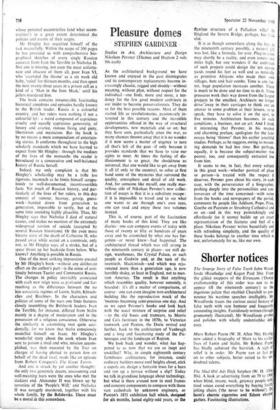Pleasure domes -
STEPHEN GARDINER
Studies in Art, Architecture and Design Nikolaus Pevsner (Thames and Hudson 2 vols 90s each) - As the architectural background we have known and enjoyed in the past disintegrates and its contemporary replacements become in- creasingly chaotic, ragged and shoddy—without meaning, without plan, without respect for the individual—one finds, more and more, a ten- dency for the few good modern architects in our midst to become preservationists. They do so for the best possible reasons. Most of them started life as revolutionaries, passionately in- terested in this century and the incredible oppOrtunities offered in the way of structural developments, new materials and so on; but they have seen, particularly since the war, so many chances thrown away that it is no wonder if it now seems a matter of urgency to save all that's left of the past—if only because it provides standards that we have to raise our sights to meet. At times the feeling of dis- illusionment is so great, the shoddiness so universal, that one would like to get away from it all (if only to the country), to solve at first hand some of the mysteries that surround the quality, atmosphere and detail of old work. And,,for someone like myself, one really mar- vellous side of Nikolaus Pevsner's new collec- tion of essays is that it is a substitute escape: if it is impossible to travel and to see what one wants to see through one's' own eyes, one can read and enjoy these two volumes instead.
This is, of course, part of the fascination of many books of this kind. They are like diaries: one can compare events of today with those of twenty or fifty or hundreds of years away and be astonished by what one has for- gotten—or never knew—had happened. The architectural thread which was still strong in the nineteenth century in places—see mill de- sign, warehouses, the Crystal Palace, or such people as Godwin and, at the turn of the twentieth, Mackintosh—and which was reju- venated more than a generation ago, is now horribly shaky, at least in England, not to men- tion America. The result is that anything which resembles quality, however remotely, is hoarded : it's all a matter of comparisons, of course—one can even imagine non-architectural building like the reproduction muck of the 'twenties becoming semi-precious one day. And so we open Pevsner's books and look back with the usual mixture of surprise and relief —to the old buses and tramcars, to Morris and Co's furniture in the 1870s, to Victorian ironwork and Paxton, the Doric revival and further, back to the architecture of Vanbrugh and a long and fascinating study of the Pic- turesque and the landscape of Repton.
We look back and wonder, what has hap- pened to us now that we are so inept and unskilled? Why, in simple eighteenth century farmhouse architecture, for instance, could ordinary builders move roof heights about, stick a cupola on, design a fantastic truss for a barn and run up a terrace without a slip? Today we talk in grandiose language about technology, but what is there around now in steel frames and concrete components to compare with those vast cathedrals by unknown engineers, or Paxton's 1851 exhibition hall which, designed for six months, lasted eighty-odd years, or the
flawless structure of a Palladian villa? In England the Severn Bridge, perhaps, but little else.
It is as though somewhere along the line. in the nineteenth century possibly, a natural gift was lost, like a formula, for ever. Plug-in cities may shortly be a reality, and even towers two miles high, but one wonders if the architects of such projects could design the ten square yards round his feet as well and as naturally as primitive Africans who made their own villages, huts and hair combs. Time is one fac- tor, huge population increases another. There is much to be done and no time to do it. These pressures work their way down from the largest projects to the smallest. Architects no longer drive-away in their carriages to think out an answer to some problem at their leisure, so to speak, they have to solve it on the spot, in five minutes. Architecture becomes, in such conditions, a business, not an art. And I think it interesting that Pevsner, in his modest and charming preface, apologises for the later essays being 'thinner' than his earlier youthful studies. Perhaps, as he suggests, owing to mount- ing demands he had less time. But perhaps, equally, it is because the subject-matter was poorer, too, and consequently extracted less from him.
It seems to me, in fact, that every subject in this great work—whether portrait of place or person—is treated with the respect it deserves. Pevsner goes about his story, in each case, with the perseverance of a biographer, probing deeply into the personalities and con- troversies of the time concerned—with notes from the books and newspapers 'of the period, comments by people like Addison, Pope, Price, Goethe on Paestum or Strasburg Cathedral and so on—and in this way painstakingly and effortlessly (so it seems) builds up an exact representation of the features and feel of a place. Nikolaus Pevsner writes beautifully and with refreshing simplicity, and the quality of these books belongs to another time which is not, unfortunately for us, like our own.


































 Previous page
Previous page